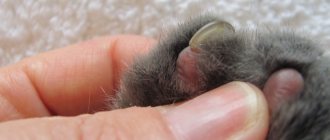Home » Useful Information
It is impossible to say definitively what influences the character of cats more - genetics or upbringing. A baby born to a naturally friendly mother has a better chance of growing up affectionate and good-natured. Some breeds are naturally angry, and it is quite difficult to correct their behavior. However, the upbringing and behavior of the owner plays an important role in shaping the character of animals. If you know how to make a cat kind, you can raise an affectionate pet even from a representative of the most genetically aggressive breed.
- 2 Regular games and petting
- 3 Treaties instead of punishments
- 4 Grooming
- 5 Ensuring comfort
Hooray? Victory?
Goodbye scratched hands! Now my beast will surely become the most affectionate cat! We hasten to disappoint: failure to fulfill at least one of the conditions can lead to open aggression, but strict adherence to all recommendations does not guarantee a sociable character. The fact is that all the advice on the topic “How to make a cat affectionate” does not work in a number of cases:
- if the kitten has inherited a quarrelsome character, that is, there is a “harmful gene”, you will have to put up with some inconveniences. Hereditary aggression does not recede in the face of proper upbringing, but only subsides a little. This is why breeders remove all cats with mental disorders from breeding;
- if a kitten is born in a basement, and its mother is a semi-wild cat, hissing at all passers-by and attacking anyone who dares to reach out to the kittens, the baby’s character will never become absolutely trusting. Wildness is an explosive mixture of genetics and early experience; coping with it is very difficult or impossible in some cases;
- debates on the topic “Who is more affectionate, a cat or a cat?” will continue forever. And all because the character of a pet depends little on gender. An affectionate cat is a cat who is completely satisfied with life. And so that all efforts do not go in vain, it is important to remember that the pet’s health comes first. When feeling unwell, not a single cat will be happy with a new toy, will not be able to truly enjoy a delicious dinner, or will trustfully relax under a person’s hand. If your cat is aggressive for no apparent reason, be sure to take her to the vet. Perhaps this is due to a chronic illness that exhausts the pet physically and emotionally. By the way, if an unsociable cat suddenly becomes too affectionate, a visit to the doctor is also necessary - such changes can signal hormonal problems and other ailments.
Patience, attention to detail and the awareness that a cat has its own passions and interests will definitely help you raise a cozy pet from a small predator. Study the life of cats in nature - this greatly helps to understand the behavior of your pet in a given situation.
Features of feline psychology
When a person wants to make friends with someone, he tries to win him over. It's the same with cats. Experienced cat lovers say that studying the psychology of pets is an extremely exciting task. To raise an affectionate cat, you need to work hard, studying the motives of the animal’s actions. It has been noticed that the behavior of kittens is greatly influenced by the attitude of the mother cat towards people. A predator who is ready to see everyone as an enemy, capable of encroaching on the life of her children, food or territory, will not raise trusting and affectionate offspring. The behavior model of elders is very important in order to learn to survive and therefore is firmly fixed in the minds of children.
How to make contact
To properly raise a kitten, you need to be able to establish contact with it. As a rule, small tailed creatures are not afraid of people, and boldly meet guests. But there are exceptions.
When you first interact with a new pet, don't rush. The cat itself must express a desire to get closer to you. That is why you should only pet an animal if you see that the cat does not perceive it as a threat. Extend your hand forward and let the cat sniff it.
If everything is fine, and the kitten is already starting to rub against you, you can safely stroke it and pick it up. In the future, it will be possible to establish contact through various games.
A few tricks
If a pet finds itself in a new home as an adult, it usually experiences extreme stress. The animal's behavior in the first days can be unpredictable; it will take time to get used to. There are several tricks that can tame even a not very sociable cat.
After a hearty meal, cats are usually in a calm and complacent mood. It is worth taking this moment to start communicating. Calm, unemotional speech has a beneficial effect on the animal’s mood.
How to choose the right name
First you need to decide on the name of the kitten. When choosing a name, you must first of all rely on your taste. You should not call your pet by a foreign name, even if it seems interesting and stylish. The main thing is that the nickname does not hurt your ears when pronounced.
When choosing a nickname, many zoologists recommend using hissing and whistling letters, for example: s, sh, z, shch. The name should not be too long, no more than two syllables, then it will be easier for the cat to get used to it. If the nickname of purebred cats is quite long and complex, then you need to think about how it will sound in abbreviation and whether you will like it. Although all these rules are not fundamental, the main thing is that the kitten and the owner like the nickname.
Sins of upbringing and how can you correct them?
But what should you do if you came across our article after you adopted a kitten or you were not the one raising the cat? It doesn’t matter, because even mistakes and some flaws can be tried to be eliminated. This will be more difficult than initially teaching a kitten your rules and laws, but it is still possible. Let's look at the most common mistakes that were made in caring for a pet.
Wrong toilet
It often happens that a kitten starts going to the toilet in the wrong place. Often such a place can be a sofa or, much worse, your bed. What to do? First of all, you should not try to scold or beat the animal, this will be of little use. Most likely, in childhood the kitten had the opportunity to relieve itself in the bed and the wrong reaction followed.
Firstly, when a kitten appears in the house, you should not immediately take it into your bed, onto the sofa, etc. Give the baby a place, highlight a tray, show his territory. Let him not be present on your bed until he learns the rules of hygiene. Secondly, it is important to choose the right place. If the kitten does not want to go to the tray, but constantly chooses another place, put the tray there.
Gnawing or tearing things, curtains, bedspreads
Having noticed the slightest interest of a kitten in furniture or home textiles, one should not allow this habit to develop. To do this, it is best to use a regular water spray. Cats really don’t like water, and such a surprise will help to quickly and effectively wean them from harmful actions. At the same time, it is important to keep an eye on the miscreant and always prevent even the slightest intentions of approaching the curtains.
What should you sharpen your nails on?
If we're talking about claws, be sure to buy your kitten a scratching post and show him how to use it.
Place the kitten's paws on its surface, let him feel how his claws cling to it, soon he will use it with pleasure and without your help. If you notice that the scratching post is not enough for him and he scratches your furniture, forbid him to do this, saying sternly: “No!” and transfer it to the scratching post. Some people advise smearing the areas of furniture where the kitten played with orange peel; cats really don’t like this smell; this can help stop the kitten from damaging the furniture.
Balinese cat
This breed is also called the “Siamese with ermine mantle.” In addition to their beautiful appearance, animals are distinguished by their sharp mind. Cats can easily open and close any door, open drawers and find hidden objects.
Don't be fooled by the proud, arrogant and unapproachable appearance of the Balinese cat. They are very affectionate and friendly.
Cats of this breed love not only attention, but also long conversations with the owner, lying on his lap.
The influence of genes on character
Not all cat breeds are prone to familiarity, affection and games. By crossing different breeds to achieve a certain appearance, breeders also “cross” different character traits of the animal. And although it is not customary to breed aggressive animals, there are breeds that are more affectionate and, accordingly, there are independent ones or simply not tame ones.
So it is believed that the British are very calm, friendly, patient, but they do not like to be disturbed or picked up
For a Briton, personal space is very important, and if it is invaded, the cat will avoid contact and run away to a secluded place
Representatives of the Maine Coon breed also do not have the most affectionate character. In the complete absence of aggression, this animal will not climb onto your lap. These cats take a very long time to get used to those around them, and then choose a pet for themselves in the family, to whom they show restrained but devoted love.
Siberian cats are the most affectionate by nature, and if they see kindness and patience in response, then this is exactly the cat that will sit on your lap with gratitude and purr with pleasure.
Do not think that breed is a fundamental component of character. For example, Persians, who are considered good-natured phlegmatic people, allowing themselves to be caressed as much as they want by their owner, will also react to the annoying pestering of children. Genetic data should be taken into account when choosing a kitten, but proper upbringing and love will do the rest.
Regular play and petting
Daily stroking and scratching helps make the cat sociable. If the owner is busy with other things and prefers to throw a lot of toys at the pet so that he can have fun on his own, the distance increases. Felinologists warn that frequent tactile contact socializes the pet, develops its intelligence, and calms it down.
During petting, it is important to observe what kind of contact the cat likes and what he does not accept. For example, most animals do not like to have the base of their tail touched. Some people react negatively when their stomach is touched. In any case, you should not insist on petting if the cat moves away or tries to hide.
Another option for a soft toy
It is aromatic and delicious thanks to catnip, an aromatic and flavoring additive. Cats love to chew on these devices. Time spent with a mint toy is not just a game, but also the prevention of caries. The product has a structure that removes plaque—soft and hard—from the teeth of a domestic predator.
Delicious and aromatic “Mint Leaf”
Continuing the theme of soft toys for cats, it is worth paying attention to the puppet toy.
To make it you will need:
- an ordinary soft toy (you can also use the options that were shown in the master classes above);
- stick (or regular pencil);
- glue.
Toys on sticks
You need to cut a small hole at the bottom of the soft toy.
It should correspond in size to the diameter of the stick.
If filler comes out of the toy, the excess should be removed.
The animal should not be allowed to try to swallow the filler.
Next, apply a drop of glue to the tip of a stick or pencil and place it inside the toy.
It is not advisable to use tape in this situation, as it is less secure and may pose a health hazard to the cat if it swallows it.
When the puppet is ready, you can call the cat and wave this toy in front of him.
An interested animal can pounce on her and pat her.
The main thing is that the pussy plays with the puppet under the supervision of the owners.
Original part
Making a cat's face (first option)
Master class “How to make a cat out of paper”: making a face using the first method:
Read also: How to properly make a hood in a bathhouse
- Place a square sheet of paper in front of you (Illustration 1).
- Fold the top right and bottom left corners together. The result will be a triangle (Figure 2).
- Fold the left corner of the triangle down so that its tip is flush with the bottom, but not touching it (as in Illustration 3).
- Fold the right corner in the same way as the left (Illustration 4).
- Fold the middle corner up slightly, as in illustration 5.
- Turn the figure over.
- Draw the eyes, nose, mouth and antennae (Illustration 6). You can also add eyebrows.
The cat's face is ready!
How not to behave around a cat
Cats are quite freedom-loving and touchy creatures. If the owner has ever offended the cat, the cat will never approach him again. And you can’t even dream of him jumping onto your lap. If the cat receives affection and attention from the owner, then gradually he will get used to the person and respond with mutual affection.
It should be remembered that cats will never do anything against their will. There is no need to forcefully hold them on your knees; this still will not lead to the desired result. The animal itself must want to sit or sleep on its owner’s lap.
If a small kitten tolerates the owner’s caresses normally, then at the first sign of anxiety, it should be released. When the animal begins to nervously beat its tail on the floor, it says that I’m tired, I have a lot of things to do.
Taming an adult wild cat
An adult feral cat has either never had a home of its own, or has had negative experiences with people and has forgotten how to trust them. To establish contact with an animal, the following conditions must be met:
- Communicate with wild animals in a calm environment.
- Do not grab or make sudden movements.
- You can wait until the cat shows interest and lure it with a treat.
- Try to pet the animal if the cat comes close or jumps onto your lap. But at the first sign of dissatisfaction, it is better to remove your hand.
You need to make sure that the cat is not frightened by the strong smell from clothes, too loud a voice, or any other factors of the new external environment. Cats are very careful animals; in order to relax, they need to feel completely safe.
We prepare and accustom to the latrine
A small kitten needs to be accustomed to a litter box or a special place to relieve itself. Many owners of babies complain about insufficient upbringing and problems with cleaning up excrement. This is not the fault of the animals, since evolution did not prepare them for the norms of upbringing in a home environment. Therefore, you need to give your child the required habits.
- Purchasing a kitten and professional breeders guarantees initial education for the ward. All you have to do is buy a tray with a similar filling so that the familiar smell refreshes your acquired knowledge. Simply lower the kitten into a container with a small border after eating.
- The same strategy will help at the stage of cultivating the habit of relieving yourself in a designated place. Place the tray and food bowl close to each other, because babies have little control over excrement. After eating, stir the storage tank, and instinct will force a young cat to dig a hole in a suitable place.
You should not scold an animal for excrement in the wrong place, and under no circumstances poke it into a puddle for educational purposes. Soak a napkin in the liquid and smear the tray with it, then clean the “disaster” area and thoroughly remove foreign odors.
If the habit of relieving yourself in one place is not eradicated over time, think about moving the tray, and the problem will be solved by itself.
Keep the kitten's excrement area clean: change the litter regularly and promptly dispose of contaminated areas.
It is important to know!
Small males of the cat family often “mark” the corners of the apartment. This is an important instinct, and brute force should not be used against an animal for educational purposes.
Don't forget about care!
Accustom your kitten to hygienic grooming procedures. Brush your kitten every day. This is not very pleasant for the cat, but it is good for the fur, so let the baby get used to brushing from childhood.
Clean your ears and eyes, trim your claws.
The sooner you teach your kitten to bathe, the easier this procedure will be later.
There is dry cleaning in the form of aerosols that are sprayed onto the coat and combed out along with the dirt. It is advisable to carry out water procedures no more often than once every two months.
You need to bathe your kitten using special shampoos that match the type of coat. The pet store will advise you and help you choose the right shampoo.
Of course, bathing is stressful. Do not scream or hit the kitten if it struggles. Choose a comfortable water temperature for the kitten, which will be closer to the kitten’s body temperature, about 38-39°C. Affection and kind words will help the kitten relax. Bathe the kitten in a basin; it is better not to use a shower head, this may frighten him. In another basin, wash off the shampoo.
It is better to dilute the shampoo with a little water in advance, so it will lather faster and easier. Soapy water should not get into the kitten's ears, mouth, eyes and nose. Leave your head dry; you will wipe it with a wet palm towards the end of the bath.
After washing, wrap the kitten in a large towel and dry it with a hairdryer set on a low setting so as not to burn or scare the kitten.
Caress the kitten, this will calm him down and bring a lot of pleasant emotions, and will also establish a trusting relationship between you.
If we define the upbringing of a kitten by one principle, then it consists of one thing: do not allow the kitten to do things that you would not want your pet to do as an adult.
kittens grow up must change, but your love and patience must remain unchanged. If you want a soft, affectionate and obedient pet, then raise him with affection and love!
Love animals, let this feeling decorate your life!
What not to do when catching and taming a cat
Felines can be carriers of diseases, most of which have no obvious symptoms. To avoid possible unpleasant consequences, show the cat to a specialist before transporting it home. If you have to take it to the veterinary clinic by car, then place a trap with the animal on the seat, covering it with a towel or blanket. Upon arrival, remove it from the trap (portable container) safely.
If the cat stays in the apartment before visiting the veterinary clinic, quarantine is required. Place the cat in a separate room, isolating it from people.
Before bringing a stray cat home, check its health by contacting a veterinarian
When catching a cat on the street, do not use bags, blankets, sacks or other similar items. A frightened animal can seriously bite and injure a person, which is dangerous for humans, since a cat can be a carrier of the rabies virus.
In order for an animal to quickly turn into a pet, you need to know what not to do during the period of its socialization, namely:
- tame a cat if you do not plan to leave it in the house forever;
- contact the animal before visiting the veterinarian to avoid possible diseases;
- look into his eyes: animals perceive such a look as a threat;
- handle wild cats with your bare hands - you need to protect yourself from bites and scratches by wearing thick clothes with long sleeves and gloves;
- overfeed the animal - the amount of food should be increased gradually;
- picking up a cat when he doesn’t want to - this will slow down the socialization of the animal;
- show aggression towards the animal.
We suggest you familiarize yourself with Breeding rabbits in pits and burrows
Spray bait
Sometimes a cat must be accustomed to being handled using a special bait spray, which is sold in a pharmacy and usually contains catnip extract; this is necessary in cases where the kitten has been running wild for a long time and categorically refuses to make contact. Most often, this phenomenon is observed if the animal has suffered from people and because of this cannot help but fear even its owner, who loves it and has created comfortable living conditions for it. Also, basement kittens, which have largely returned to the behavior of their wild ancestors, are often distinguished by distrust.
The spray should be applied not to clothes, but to the palms of the hands, so that the kitten gets used to the person, and not to the thing. The smell of the product acts on the animal like a drug, and therefore the pet will, despite its fear, still run to the owner and rub against the hands. Gradually, the kitten will understand that there is nothing dangerous or unpleasant when communicating with a person. As a result of this, in the future, even without a spray, the pet will be willing to be handled.
When using a spray, it is important not to exceed the norm so that the baby does not become accustomed to it and begins to suffer from the lack of the drug. Because of this, you cannot use the product more often than once a day. This remedy should be used more often if you had to take an adult cat into your home.
Regarding your kitten's litter box
A separate topic is cat litter. If you bought a kitten from a professional breeder, then most likely the kitten is already litter box trained. All you need to do is purchase a similar tray and the same litter for the toilet, so that the familiar smell will help the kitten find its way around. You just need to show the kitten where the tray is by placing it there after eating.
The same advice applies to kittens that have not been litter box trained beforehand and you will have to do it yourself. Buy a tray with low borders to make it easier for a small kitten to get inside. Pour filler into the tray. When the kitten has eaten, immediately put the kitten in the tray. The fact is that in small kittens the need to defecate occurs quite quickly after eating food. Rumble the litter, instinct will force the kitten to dig a hole, and he will want to go to the toilet in it.
Do not scold the kitten too much if it relieves itself somewhere in the apartment. Don't poke his face into the puddle. Wipe it off with a napkin
place and smear the tray with the same napkin. By the smell, the kitten will understand what to do next time. Wash the place where he misbehaved thoroughly with odor-eliminating products.
Keep the tray clean, change the filler regularly, getting rid of contaminated areas.
The kitten must have a sleep, rest and play schedule; feeding must be strictly on schedule at a certain time.
At what age should you adopt a kitten to make it easier to raise it?
Breeders recommend adopting kittens at the age of 3 months. By this time, the baby becomes independent and it is easier for him to part with his mother. A kitten that has not experienced severe stress from a change of home will be more contactable with humans. A raised animal has a lot of advantages over a baby.
:
- the kitten is already socialized and ready to learn;
- the animal is accustomed to the tray and scratching post;
- some of the cats have already been neutered, so they are more affectionate towards their owner;
- the animal knows the rules of behavior in the house.
It will be easier to raise a grown cat than a 1-2 month old baby. The animal is already socialized, so the learning process will not be difficult. When choosing a pet in a breeder's home, give preference to friendly, affectionate kittens who will make contact themselves.
Video “Education in secret by Yu. Kuklachev”
In this video you can learn the secrets of caring for and raising these predators from their greatest trainer, Yuri Kuklachev.
Sorry, there are no surveys available at this time.
Raising a kitten should be done from the very first day of its stay in the house. However, you need to act correctly so as not to intimidate or anger your pet. Let's find out how to raise a kitten so that its relationship with its owners is friendly and harmonious.
The main task in raising a kitten is to find a balance between demandingness and respect for the pet’s personal space. It must be taken into account that the hierarchy of domestic cats is more complex and subtle than that of lions and, even more so, that of dogs. Animals that are in frequent contact (for example, in the yard) still catch mice alone, and this eliminates the emergence of the “vertical of power” necessary for successful hunting in a pack. Accordingly, it is useless to raise a kitten using the “dog” method, positioning yourself as the leader.
The main secret in raising cats is that they must understand what behavior is beneficial for them and what is not: right actions should be encouraged, dirty tricks should be suppressed, but without rudeness and humiliation.
It is important to devote enough time to the animal: even an initially affectionate and trouble-free kitten, left to its own devices, quickly becomes wild. To raise a pet tame, you need to play with it more often, talk to it, and not show indifference when the animal wants to be petted. But at the same time, you shouldn’t impose yourself, if the cat wants to be alone, this will only cause hostility.
Another important point is the inviolability of the place to rest. Felines have the concept of a “territory core,” in which the individual is the absolute master and should feel completely safe. For pets, this “center” is usually their house or favorite lounger. Forcibly removing an animal from its shelter will make it unbalanced or aggressive.
You need to accustom your pet to the tray from the first day of living in the house. Place your baby there immediately after eating or waking up. If the kitten manages to shit in another place, wipe off any traces of his activity with a rag and put it in the tray, and carefully disinfect the place of the “crime” so that there is no smell left there. You can spray the tray with a special spray with pheromones.
It is more difficult to re-educate an animal with an already formed character, but it is also quite possible. First of all, you need to understand why exactly the cat is behaving badly.
A pet may act out because at one time he was indulged too much or was not given attention. In this case, use the same strategy as in raising a kitten: reward correct behavior and scold for unacceptable behavior. Sprays containing unpleasant odors for cats, such as citrus fruits, will help scare your pet away from places where they are not allowed.
An animal may be intimidated or aggressive if it has been abused by previous owners. In this case, you need to behave towards the pet as gently as possible and reduce punishment to a minimum. As with a kitten, avoid stress such as noisy guests or loud music. In difficult cases, it makes sense to contact a zoopsychologist.
And kindness, but sometimes the obstinate animal literally begins to drive some family members crazy. To prevent this from happening, it is important to decide from the very first days how to raise a kitten. As you know, a cat walks on its own, and the more it understands what they want from it, the more persistently it will do the opposite. However, there are some tricks that will allow you to cope with even the most naughty kitten.
Education of personal qualities
How to bury a cat and where to do it correctly.
How to raise a kitten correctly so that living with him in the same apartment does not cause inconvenience? In order for a kitten to grow up obedient, you should spend time with him as often as possible, talking about what he can do indoors and what not. A cat is able to react to the slightest change in a person’s intonation. Therefore, it is absolutely not necessary to shout at the furry purr. It is enough just to change the intonation, scolding the baby for mischief or praising him for success.
Important! You should be patient and not expect your cat to learn new skills too quickly.
How to raise a cat to be calm and tame? To prevent the kitten from causing chaos in the house and damaging the furniture, you should provide it with free access to toys. In your free time, it is important not only to caress your furry pet, but also to play outdoor games with it so that the animal releases energy and is obedient when the owner is away from the house. If a kitten begins to scratch and bite heavily during play, you need to make a remark and switch its attention to some object (a ball, a rope with a toy, or an artificial mouse).
In order to achieve calmness for the animal in situations where there is a joint trip in the car or a walk in the yard, it is important to create the most comfortable environment for him. To do this, the cat must be placed in a comfortable carrier and given time to get used to the confined space. It is advisable to pet your pet at this time so that the kitten copes with stress. Only after this can you hit the road.
Often cat owners are interested in how to teach their pets not to disturb them at night. In this case, it is recommended to give a prohibitory command in a stern tone at the moment active night games begin. If this does not work, you need to take your pet in your arms and place it next to you on the bed. The kitten, feeling the owner’s hand, will calm down and go to bed. To ensure that the animal does not disturb the night's rest, the steps described above will need to be repeated every night. Gradually, the fluffy purr will get used to the fact that in the dark you can’t make noise.
Important! To prevent the kitten from growing up aggressive, you should not allow shouting or loud noise in the house. Treatment of both the tailed boy and the girl should be soft and gentle.
Training will help you raise a calm pet
Raising an affectionate pet
Often bad character is explained by simple bad manners. From the first days of a kitten's life, you need to raise it patiently but persistently. Inconsistent actions of the owner will cause bewilderment, irritation, and then aggression in the animal. If you allow your cat to sleep on your bed today, and tomorrow you drive it away due to excessive “cheekiness,” then the only thing you can achieve is fear and stress. Such a cat will develop distrust of its owner. Subconsciously, she will wait for a catch and simply won’t go along, expecting a sharp shout or a slap for her sympathy.
It is also necessary to take into account the physiological characteristics of cats. Cats are very sensitive to smells. A strong or unfamiliar aroma can provoke even the most affectionate cat into unusual behavior. An attempt to take your pet with hands smeared with cream, or press it to a perfumed chest, at best will result in flight, at worst - a desire to protect yourself from the “stranger”.
Such behavior that irritates a person, such as scratching furniture and walls, is not only a natural desire to “sharpen” an important tool for a predatory hunter - claws. It turns out that on the paw pads there are glands that secrete a special secretion with which the animal marks its territory.
Trying to wean someone from doing such things using shouting and punishment means getting an angry neurasthenic instead of a pet. It’s better to say firmly, quietly: “You can’t!” - and transfer the cat to the scratching post. Not immediately, but the animal will stop spoiling the furniture and the owner’s nerves. Sometimes loud, demonstrative scratching is the cat’s desire to draw attention to himself.
Often we don’t even understand that some action of a cat signifies his affection and love. If a person trips over a fluffy handsome man who, like in a circus, is trying to walk next to his feet and screams loudly, then instead of irritation at the inconvenience, one should experience a feeling of pride and gratitude.
With a loud meow, the cat expresses joy and greets you. And he rubs against his legs to declare that this person is his, showing his special affection. So maybe we don't understand the signals that "unkind" animals use to express their love to us.
Inappropriate behavior may indicate that the cat is sick, scared, irritated, or offended by lack of attention. To understand a cat correctly, it is worth learning its language.
When to start raising a kitten, how and what to teach it
The optimal age for parenting occurs immediately after the adaptation period. Be attentive to the kitten's habits if it is more than 3 months old. It is extremely important to correct your pet’s behavior gently, in a playful or rewarding way.
. Don’t even think about hitting a kitten for training purposes; this will make your pet more nervous and timid, but not at all obedient. Avoid stressful situations
up to 6 months of age of the kitten:
- Frequent arrivals of guests, noisy parties or celebrations. Yes, it is a sacrifice, but it is made to strengthen your pet's psyche.
- Walking on a leash is of no use to the baby; he needs to fully explore the home, every cabinet and every shelf. In addition, a pet that has not received it should not come into contact with street animals, this is fraught with viral diseases, sometimes fatal.
- Punishment - at this age, the kitten is very pliable and its behavior must be corrected exclusively with positive motivation.
Cats are very receptive to training until they are one year old.
, this period is quite enough to master basic skills. The first priority is this. On the very first day, keep an eye on the baby, as soon as he starts to “fumble” in search of the toilet, transfer him to. If you don't have time, quickly blot up the puddle with a paper napkin and place it in the tray. Even 2-month-old kittens have a keen sense of smell and rely on it when searching for a litter box.
Important!
If you have multiple cats in your home, get extra litter boxes! Firstly, each pet should have its own toilet, and secondly, do not forget that some cats go to different litter boxes - big and small.
Try to take the kitten to the toilet 15–20 minutes after feeding
and stay with the baby until he relieves himself. It is worth refraining from frequent cleaning of the tray, since fresh litter does not have a characteristic odor. Keep the trophy napkin (or replace it with a piece of cloth), praise your ward every time until the habit of going to the litter box is established.
Food
Cats, by their nature, are not picky eaters; they become rabid gourmets only at the suggestion of their owners, who, wanting to pamper the kitten, ultimately begin to suffer from the fact that the pet’s taste priorities begin to go off scale.
A kitten's diet must contain the entire list of useful substances that allow it to grow and develop correctly. Food from the table is very harmful for animals, if you want to please your baby and succeed in the question of how to raise a kitten to be affectionate, feed him food that is healthy for him, for example, boil fish with oatmeal.
By the way, it is during feeding that it is optimal to accustom the kitten to its name. You should speak in a gentle voice, constantly repeating his nickname.
Congenital features
By nature, every cat is a proud and affectionate animal, obeying its owner only for practical reasons. Innate egoism lies in the response to the actions of the “big brother”. If his behavior is hostile, the baby, and then the adult, will be withdrawn and aggressive.
Practicality is manifested in the fact that the kitten will never perform manipulations that do not benefit it. Therefore, one of the methods of education is to portray any negative action in an unfavorable, useless light. Then it’s worth showing another, more attractive pastime.
The rules of upbringing and training were developed over the years of close attention to representatives of the furry kingdom. Here are the results of many years of work:
- Educational activities are initiated from the first day of joint stay in the apartment/house.
- Do not encourage the kitten's familiar attitude, show that you are the master of the situation here and demand that certain rules be followed.
- Taboo on aggressive behavior and the use of brute physical force.
- Do not intimidate your pet with loud screams or sudden movements of the limbs.
- A proud pet will not tolerate humiliation. If you poked your nose into his puddle, this will cause an outbreak of resentment and vendetta in the future.
- A kind attitude will help raise a kitten to be affectionate and tame.
- The cat's perception acutely senses your emotional state and voice accompaniment. Therefore, to indicate an error, a sharp “chopped” phrase is enough: “You can’t!”, “No!”, “Scram!”
- The mental abilities of cats are at a high level, but acquiring skills, habits and abilities will take time and effort.
What not to do
Even if the kitten is reluctant to make contact, does not want to sit quietly on your hands or knees, never scream, and especially do not hit the animal. Violent disrespect will only make the situation worse. Just patience and consistency in action.
Do not grab the kitten by the scruff of the neck, do not pull the front legs, and do not make sudden movements.
The animal should not feel that you are a threat. Your hands should evoke only positive associations. Make the animal want to sit on your hands and lap.











